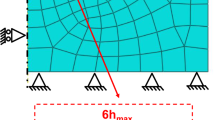Abstract
The connection between parameters that can be measured by means of instrumented indentation with the real mechanical properties has been a matter of discussion for several years. In fact, even hardness is not a readily measurable magnitude since the real contact area depends on both the elastic and plastic properties of the sample. Recently, Dao et al. [Acta Mater49, 3899 (2001)] proposed a method based on numerical fittings to calculate by a forward-reverse algorithm the elastoplastic properties of a sample from the load-penetration curve obtained with a sharp indenter. This work will show, in contrast, that it is not possible to measure uniquely these mechanical properties of a sample in that way.
Similar content being viewed by others
Change history
01 May 2005
An Erratum to this paper has been published: https://doi.org/10.1557/JMR.2005.0053e
References
W.C. Oliver and G.M. Pharr: An improved technique for determining hardness and elastic modulus using load and displacement sensing indentation experiments, J. Mater. Res. 7, 1564 (1992).
M. Mata, M. Anglada and J. Alcalá: Contact deformation regimes around sharp indentations and the concept of the characteristic strain, J. Mater. Res. 17, 964 (2002).
Y. Choi, W.-B. Lee, S.-H. Lee and D. Kwon: Indentation curve analysis for pile-up, sink-in and tip-blunting effects in sharp indentations, in Thin Films—Stresses and Mechanical Properties X, edited by S.G. Corcoran, C.-Y. Joo, N.R. Moody, and Z. Suo. (Mater. Res. Soc. Symp. Proc. 795, Warrendale, PA, 2004) p. 11.
J. Alkorta and J. Gil Sevillano: Measuring the strain rate sensitivity by instrumented indentation. Application to an ultra fine grain (equal channel angular pressed) eutectic Sn-Bi alloy, J. Mater. Res. 19, 282 (2004).
J. Alkorta and J. Sevillano Gil: Medida de la dureza de sólidos mediante nanoindentación, B. Soc. Esp. Cer. Vidrio. (in press, 2005).
K.W. McElhaney, J.J. Vlassak and W.D. Nix: Determination of indenter tip geometry and indentation contact area for depth-sensing indentation experiments, J. Mater. Res. 13, 1300 (1998).
B. Taljat, T. Zacharia and G.M. Pharr: Pile-up behavior of spherical indentations in engineering materials, in Fundamentals of Nanoindentation and Nanotribology, edited by N.R. Moody, W.W. Gerberich, N. Burnham, and S.P. Baker (Mater. Res. Soc. Symp. Proc. 522, Warrendale, PA, 1998), p. 33.
I.N. Sneddon: The relation between load and penetration in the axisymmetric boussinesq problem for a punch of arbitrary profile, Int. J. Engng. Sci. 3, 47 (1965).
I.N. Sneddon: Boussinesq’s problem for a rigid cone, Proc. Cambridge Phil. Soc. 44, 492 (1948).
M. Dao, N. Chollacoop, Van K.J. Vliet, T.A. Venkatesh and S. Suresh: Computational modeling of the forward and reverse problems in instrumented sharp indentation, Acta Mater. 49, 3899 (2001).
T.-Y. Cheng and M.-C. Cheng: Relationship between hardness, elastic modulus and the work of indentation, Appl. Phys. Lett. 73, 614 (1998).
T.-Y. Cheng and M.-C. Cheng: Scaling, dimensional analysis, and indentation measurements, Mater. Sci. Eng. R. 44, 91 (2004).
T.-Y. Cheng and M.-C. Cheng: Can stress-strain relationships be obtained from indentation curves using conical or pyramidal indenters? J. Mater. Res. 14, 3493 (1999).
T.W. Capehart and T.-Y. Cheng: Determining constitutive models from conical indentation: Sensitivity analysis, J. Mater. Res. 18, 827 (2003).
K.K. Tho, S. Swaddiwudhipong, Z.S. Liu, K. Zeng and J. Hua: Uniqueness of reverse analysis from conical indentation tests, J. Mater. Res. 19, 2498 (2004).
G.M. Pharr and A. Bolshakov: Understanding nanoindentation unloading curves, J. Mater. Res. 17, 2660 (2002).
A.F. Bower, N.A. Fleck, A. Needleman and N. Ogbonna: Indentation of a power law creeping solid, Proc. R. Soc. London A441, 97 (1993).
B. Storåkers, S. Biwa and L.-P. Larsson: Similarity analysis of inelastic contact, Int. J. Solids. Struct 34, 3061 (1997).
J.C. Hay, A. Bolshakov and G.M. Pharr: A critical examination of the fundamental relations used in the analysis of nanoindentation data, J. Mater. Res. 14, 2296 (1999).
N.A. Stillwell and D. Tabor: Elastic recovery of conical indentations, Proc. Phys. Soc. 78, 169 (1961).
V. Marx and H. Balke: A critical investigation of the unloading behavior of sharp indentation, Acta Mater. 45, 3791 (1997).
K.L. Johnson: Contact Mechanics, 1st ed. (Cambridge University Press, Cambridge, U.K., 1985) p. 175.
M. Mata and J. Alcalá: The role of friction on sharp indentation, J. Mech. Phys. Solids 52, 145 (2004).
M. Futakawa, T. Wakui, Y. Tanabe and I. Ioka: Identification of the constitutive equation by the indentation technique using plural indenters with different apex angles, J. Mater. Res. 16, 2283 (2001).
N. Chollacoop, M. Dao and S. Suresh: Depth sensing instrumented indentation with dual sharp indenters, Acta Mater. 51, 3713 (2003).
T.-Y. Cheng and Z. Li: Scaling relationships for indentation measurements, Philos. Mag. A 82, 1821 (2002).
Author information
Authors and Affiliations
Rights and permissions
About this article
Cite this article
Alkorta, J., Martínez-Esnaola, J.M. & Gil, J.S. Absence of one-to-one correspondence between elastoplastic properties and sharp-indentation load–penetration data. Journal of Materials Research 20, 432–437 (2005). https://doi.org/10.1557/JMR.2005.0053
Received:
Accepted:
Published:
Issue Date:
DOI: https://doi.org/10.1557/JMR.2005.0053




